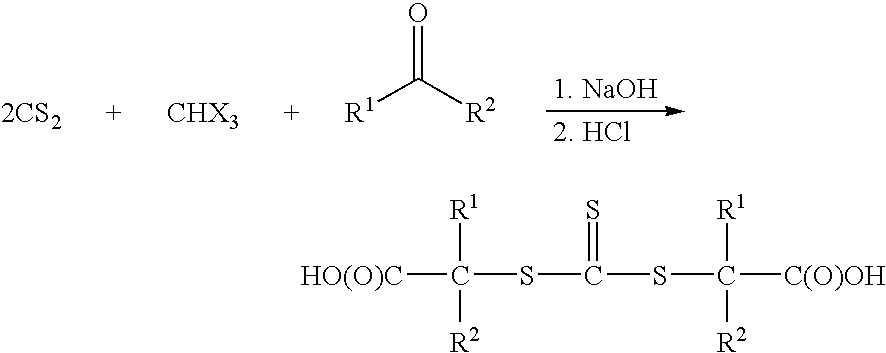Vinyl-Thiocarbonate and Polyol Containing Block Copolymers
a technology of thiocarbonate and polyol, which is applied in the field of polymer block copolymers of thiocarbonates and hydroxyl containing compounds, can solve the problems of low initiator efficiency and uncontrollable molecular weigh
- Summary
- Abstract
- Description
- Claims
- Application Information
AI Technical Summary
Problems solved by technology
Method used
Image
Examples
example 1
[0124]16 g ester is made from a carboxyl-terminated RAFT agent and bis-hydroxyalkyl-terminated polydimethylsiloxane. 335.4 g N,N-dimethyl-S-isobutyric acid dithiocarbamate (DMDTC), 1822.5 g GE Silsoft 802 (Mw˜2500) and 18 g p-toluenesulfonic acid are mixed with 1.5 liter of cyclohexane and refluxed for 8 hours. A Dean-Stark trap is used to collect water that is formed. The reaction is let to cool down to room temperature. The organic solution is decanted and concentrated to a yellow oil. HNMR confirms the formation of the ester in very pure form. In the polymerization, 70 g of the ester, 140 g 2-dimethylaminoethyl methacrylate (DMAEMA), 70 g N,N′-dimethylacrylamide (DMA), 1.75 g 2,2′-bis-(2-methylbutyronitrile) (Vazo-67) and 420 g ethyl acetate were mixed and bubbled with nitrogen gas for 20 minutes. The reaction is then heated at 75° C. for 5 hours. 0.7 g Vazo 67 is added and heating continues for 3 more hours. Solvent is removed and the block copolymer is collected as a yellow sol...
example 2
[0125]16 g ester made from Silsoft 802 and DMDTC, 34 g DMAEMA, 14 g t-butyl acrylate (t-BA), 0.4 g Vazo-67 and 21.7 g anhydrous ethanol were mixed and purged with nitrogen before heating to 70° C. for 1.5 hours before adding 0.4 g Vazo-67 in 2 g ethanol. The temperature was raised to 75° C. for 3 hours before adding 0.4 g Vazo-67 in 2 g ethanol and the reaction was kept at 80° C. for 5 more hours. Cooled down to 25 to 30° C. before a solution of 5.25 g citric acid in 80.65 g water was added to keep the temperature below 40° C. The final product is a off-white dispersion.
example 3
[0126]16 g ester made from Silsoft 802 and DMDTC, 34 g DMAEMA, 14 g t-BA, 4 g acrylic acid (AA), 0.4 g Vazo-67 and 23.1 g anhydrous ethanol were mixed and purged with nitrogen before heating to 70° C. for 2 hours 50 minutes before adding 0.4 g Vazo-67 in 2 g ethanol. The reaction was heated at 75° C. for 3 more hours before adding 0.4 g Vazo-67 in 2 g ethanol and heated to 80° C. for 5 more hours. Cooled down to room temperature and added 77.46 g water while stirring to give a yellow-colored dispersion.
PUM
| Property | Measurement | Unit |
|---|---|---|
| critical micelle concentration | aaaaa | aaaaa |
| molecular weights | aaaaa | aaaaa |
| polydispersity indices | aaaaa | aaaaa |
Abstract
Description
Claims
Application Information
 Login to View More
Login to View More - R&D
- Intellectual Property
- Life Sciences
- Materials
- Tech Scout
- Unparalleled Data Quality
- Higher Quality Content
- 60% Fewer Hallucinations
Browse by: Latest US Patents, China's latest patents, Technical Efficacy Thesaurus, Application Domain, Technology Topic, Popular Technical Reports.
© 2025 PatSnap. All rights reserved.Legal|Privacy policy|Modern Slavery Act Transparency Statement|Sitemap|About US| Contact US: help@patsnap.com



